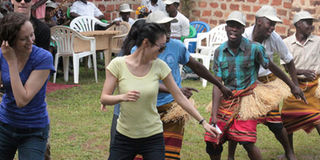How cultural exchanges market Uganda’s arts

New York University students perform a traditional Ugandan dance with students of Keenote Centre. Photo by Brian Magoba.
On January 11, the strains of Osibire bubi muwala we buyodi adokho, a song from the Samia ethnic group, wafted down the hallways of Fang Fang Hotel in Nakasero.
The singer was Ian Collense, a gregarious Australian student, who is on a Study Abroad programme, which has brought students from New York University (NYU) to Uganda every January since 2007.
Themed projects
Two days later, he performed the Owaro dance alongside students of Keenote Centre in Mukono, almost upstaging them with how confidently he sang songs like Adokho, Orado, Auma wunyekele, Tula erwanyi, and Sesa alambe.
Collense had spent five days learning six Samia songs, and another four from the Ankore’s ekitaguriro dance, during the workshop phase of the cultural exchange with dance students from Makerere University’s Department of Performing Arts and Film (DPAF).
It shares a formula with like-themed projects in which they collaborate in workshops and the product is part of a showcase performance, which usually free to the public. In between, the Ugandans play host, tour guide, translator, and chaperone.
Gray areas are many. For example, is it really fair exchange when one side is giving authentic traditional dance and another is offering personalised choreography? If the hosts are not the chief sponsors, who exercises control over the programme funds?
Personal benefits
But despite such inherent challenges, the experience is largely mutually beneficial to all who participate in the exchange programmes.
A case in point is Mabingo AlfDaniels, currently a Fulbright Scholar doing a Master’s degree in Dance Education at New York University.
“Yes, I had lobbied and applied several times, but I believe when I added the experience of the NYU-DPAF collaboration to my submission, it greatly helped my chances of winning the scholarship.
On a personal note, I can say this is how advantageous such programmes are,” he testified.
His equivalent on the NYU side is Yoko Sasaki, who first came to Uganda in 2009 as a “study abroad” student. This year, she returned as a Programme Assistant. Sasaki recognises the competitive edge she attained after participating in the exchange.
“Right after leaving in 2009, I applied both the positive and challenging feedback that I either observed or was told, and out of that learned to be a better programme coordinator. Google is definitely no substitute for living and earning such an experience,” she noted.
The bigger picture
Professor Jill Pribyl, the Programme Director of the NYU-DPAF collaboration in Uganda, likens the aspect of teaching Ugandan dance to exchange students to a pilgrimage: “It is like the difference between praying in church, and attending mass in Rome with the Pope giving the sermon.”
She also believes in the value of such interactions countering the stereotype image of a desolate Africa whose war-ravaged and hunger-stricken children have flies and tears on their faces.
“Foreign students who experience the various identities of Africa through the Ugandans they collaborate with can never again oversimplify the African situation,” she added.
Dispelling stereotypes
The ripple effect, on the students and the ones they teach, when they go back to their countries is how cultural exchange programmes can be a viable approach to marketing and globalising Uganda’s cultural arts; combating unflattering stereotypes and generalisations, and raising inter-cultural appreciation.
Professor Deborah Damast, the Programme Director of NYU’s Study Abroad Programme to Uganda, explained the program’s aspect of fractal theory—where its benefits reach even where the teachers and resources do not.
She used the example of Vanessa Schneller, who participated in the inaugural programme in 2007.
“Every year since then, she has been teaching the Kimandwa dance to children. Last year ,when she brought her second graders to a community workshop, they performed Kimandwa exactly as we all learned it, complete with lyrics and original dance moves.”
Unpaid ambassadors
Each year, the visiting students learn two Ugandan dances. Since 2007, the repertoire has included the Bakisimba and Amaggunju from Buganda; Ekimandwa, Ekizino and Ekitaguriro from Ankole, Gaze from West Nile, Owaro from the Samia, and Naleyo from Karamoja.
By transforming Ian and Vanessa into ambassadors of Ugandan cultural arts, programmes like the NYU-DPAF collaboration popularise and make them valuable commodities.
More so, to the visiting teachers who incorporate the knowledge attained into subsequent classes upon returning home.
“Gaze, Kizino and Ekimandwa are popular among former participants who specifically designed units on Ugandan dance and inter-cultural awareness after their time here. Is there a better way to create a discipleship for Ugandan arts and the country by association?” asked Mabingo.




